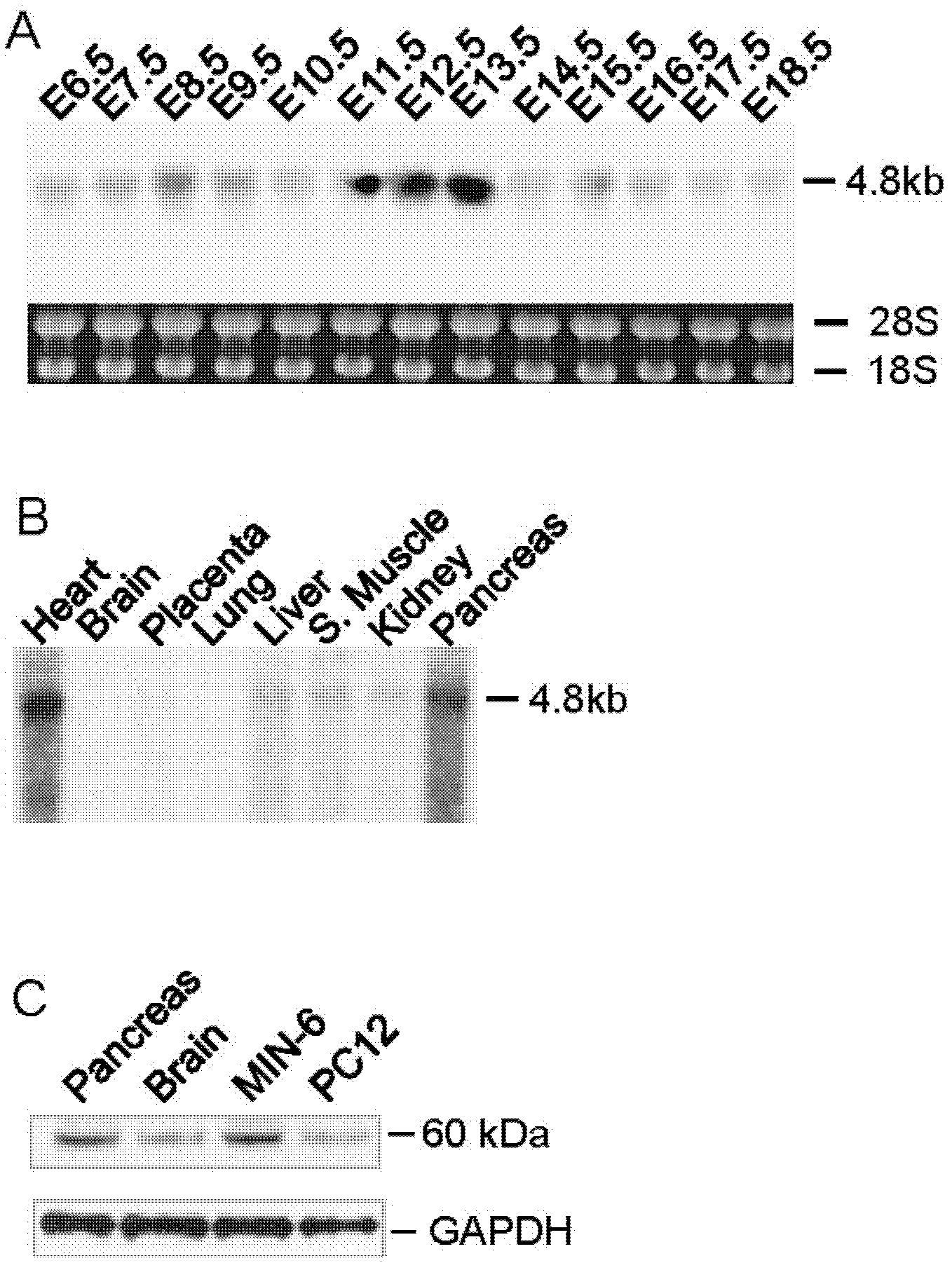Method for purifying and recognizing pancreatic endocrine cells
An endocrine and cell technology, applied in the field of purification and identification of pancreatic endocrine cells, can solve problems such as limited sources
- Summary
- Abstract
- Description
- Claims
- Application Information
AI Technical Summary
Problems solved by technology
Method used
Image
Examples
Embodiment 1
[0062] The amino acid sequence of human Insm2 is highly homologous to Insm1, which belongs to a new member of the Snail / Gfil / Insm1 family containing C2H2-type zinc finger protein transcription factors. Human Insm2 was isolated from the human islet cell tumor cDNA gene library by PCR (primer sequence: 5′-CCATCCTAATACGACTCACTATAGGGC-3′; reverse, 5′-ACAGCTGAACACCTTGTCGCACTC-3′) (GenBank acc.no., NM_032594), encoding 566 amino acid residues (Protein Database acc.no., NP_115983), the protein has a molecular weight of 60kDa and an isoelectric point of 9.46 ( figure 1 ). Insm2 shares 51% identity and 56% similarity with Insm1. Orthologous Insm1 / Insm2 exists from the nematode C.elegans to humans, suggesting that it is a relatively conserved gene family in evolution. (A) Using the BLAST program provided by NCBI to compare the high homology of the amino acid sequences of human INSM2 and mouse Insm2. (*) indicates the same amino acid, (-) indicates the absence of the best correspondin...
Embodiment 2
[0064] Insm2 messenger ribonucleic acid or INSM2 protein expression in embryonic and adult pancreatic endocrine cells
[0065] Using mouse full-length Insm2 cDNA as a probe, the Northern blot test showed that Insm2 was expressed in the embryonic period of the mouse, and the expression of Insm2 was significantly enhanced during the E11.5-E13.5 days of the pancreas development stage ( figure 2 ). Using a specific rabbit antibody against INSM2 amino acid (5-SRQVLLLQMPLRPGC-3), the results of Western blot experiments showed that Insm2 protein was expressed in adult pancreas with a molecular weight of about 60KDa ( figure 2 ). Immunohistochemical staining with an Insm2-specific antibody showed that INSM2 protein was expressed in islet endocrine cells but not in pancreatic exocrine tissues ( image 3 ). INSM2 protein is also expressed in the endocrine cells of the adrenal cortex and medulla and many brain nerve cells such as cerebral cortex neurons, hippocampus and cerebellum n...
Embodiment 3
[0070] Insm2 gene is a novel target downstream of Ngn3 and NeuroD1
[0071] Activation of Ngn3 by inactivation of Notch signaling is a critical step in the initiation of endocrine pancreas development. Recent literature shows that the Insm1 gene is a downstream target of Ngn3 (Mellitzer, et al., Embo J 2006; 25:1344-52), and also a target of NeuroD1 (Breslin, et al., J Biol Chem 2003; 278: 38991- 7). Because Insm2 is a homologous gene of Insm1, Insm2 may also be a novel target downstream of Ngn3 and NeuroD1. In addition, microarray analysis of pancreatic embryo (E18.5 days) tissues of Ngn3 gene knockout mice showed that the expression of Insm1 and Insm2 genes were significantly reduced (more than 6.3 times on average) (Juhl, et al., Diabetes 2008; 57: 2755 -61); see the database information in the bibliographic appendix). Insm1 gene-knockout mice are impaired in the development of islet cells and in the production of insulin or glucagon, suggesting that its homologous gene ...
PUM
| Property | Measurement | Unit |
|---|---|---|
| Molecular weight | aaaaa | aaaaa |
| Molecular weight | aaaaa | aaaaa |
Abstract
Description
Claims
Application Information
 Login to View More
Login to View More - R&D
- Intellectual Property
- Life Sciences
- Materials
- Tech Scout
- Unparalleled Data Quality
- Higher Quality Content
- 60% Fewer Hallucinations
Browse by: Latest US Patents, China's latest patents, Technical Efficacy Thesaurus, Application Domain, Technology Topic, Popular Technical Reports.
© 2025 PatSnap. All rights reserved.Legal|Privacy policy|Modern Slavery Act Transparency Statement|Sitemap|About US| Contact US: help@patsnap.com



